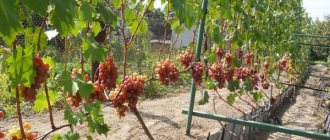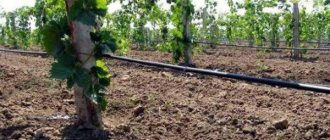Lily of the Valley grapes are a new product on the horticultural market. However, the variety has already gained particular popularity. The first mention of this variety appeared only in 2012. And he was bred by a Ukrainian breeder.
Due to the fact that initially the variety was not tested or tested in any way, and the seedlings had a fairly high cost, the variety, in principle, was not so in demand and popular. But gradually the variety became very famous. At least due to the fact that it has excellent external and taste characteristics. And also due to resistance to various kinds of diseases and pests.
Stress resistance, equanimity in the face of adverse weather conditions, excellent taste characteristics and a generally positive experience and feeling from growing this variety - all this influenced the popularity of the variety. Made him very famous. And Lily of the Valley grapes have spread quite actively in various regions of the country. And also far beyond.
Advantages and disadvantages
"Lily of the valley", along with other crops and grape varieties, has a number of advantages and disadvantages.
Among the advantages of the variety, the following are especially highlighted:
- Unique taste and aroma.
- High yield.
- Possibility of long-term storage.
- Resistant to drought, frost, pests and diseases.
- Ease of propagation and good rooting of layerings and cuttings.
- Easy to care for.
The variety does not require immediate harvesting after ripening; the fruits have high commercial quality and tolerate transportation well.
Disadvantages of "lily of the valley":
- Possibility of flowers falling due to rain.
- Harvesting too late leads to a deterioration in the consistency of the pulp.
Also, due to the fact that the variety is young, there is no data on which method of forming bushes is most effective for increasing productivity.
Advantages and disadvantages of the Lily of the Valley variety
Lily of the valley is a very promising variety that has many advantages, but, despite all the efforts of breeders, it is not yet possible to avoid the disadvantages.
Strengths of the variety:
- excellent taste and aroma of fruits;
- beautiful appearance of the bunch and berries;
- high productivity;
- good keeping quality and transportability of fruits;
- frost resistance;
- ease of propagation - easily takes root when planted by cuttings and seedlings.
Weaknesses of the variety:
- poor knowledge of the variety and, as a result, there is no data on how Lily of the Valley behaves in different climatic zones (productivity, diseases, wintering);
- average resistance to mildew and oidium and, as a result, the need for regular preventive treatments of bushes.
Video: Lily of the Valley
Origin
“Lily of the valley” is the result of selection work by V.V. Zagorulko. It was this Ukrainian amateur breeder who crossed the varieties “Kishmish Radiant” (male flowers) and “Talisman” (female flowers) and obtained a new variety of grapes, which he presented to the public in 2012.
Parents of the “lily of the valley” – “kishmish radiata” and “talisman”
“Lily of the valley” took the best from its parent plants: from the “talisman” it inherited large fruit, frost resistance and immunity to diseases and pests, and “radiant raisin” gave it the beautiful color and wonderful taste of the berries.
Methods of propagation of grapes
There are several ways to propagate the variety:
- Saplings. The most popular and easiest to implement. Ideal for first planting of grapes. A plant rooted using this method will produce gradual, moderately stable growth. The first harvest from grape bushes can only be harvested in the third year of the bush’s life.
- Cuttings. Thanks to an adult healthy rootstock, grapes begin to bear fruit at an earlier date.
- Branches from the mother bush. The branches of the grape bush itself are carefully bent to the ground, slightly buried and sprinkled with soil. In the future, watering and appropriate care are provided.
- From the seeds. The most long-term method of propagation of the Lily of the Valley variety, in which the young plant will delight with fruits no earlier than two years after rooting in a permanent place.
Main characteristics
“Lily of the Valley” is a table grape variety that, despite its recent appearance, has managed to establish itself on the positive side.
Maturation period and class
“Lily of the valley” is a grape variety of medium early ripening. When cultivated in regions with a warm climate, the crop is ready for harvest 125-140 days after bud break. In the south of Russia this is the second ten days of August, in areas with a cooler climate it is the beginning of September.
Bush
The bushes are vigorous, have powerful shoots 1.0-1.2 cm thick, the length of which reaches 3.5-4 m. The leaf blades are large, painted in a rich green color.
Reference! During the flowering period, bisexual flowers appear on the bushes, so the “lily of the valley” does not need additional pollination.
Bunches and berries
The clusters of lily of the valley grapes are medium-dense, regular conical or cylindrical-conical in shape, large - the average weight of a bunch is about 500 g, but some reach a weight of 1.0-1.5 kg.
The fruits are large, grow up to 2 cm in diameter and 3.5 cm in length, weigh 8-14, and sometimes 16-19 g, and have an elongated oval, cylindrical or heart-shaped shape.
The berries are covered with a delicate skin of bright yellow-lemon color, which is dense enough not to crack and resist attacks by wasps and other insects. The pulp is juicy and fleshy, the grapes contain 17-19% sugar and 5-7 g/l acid.
Taste
The berries are tender and juicy, have a sweet taste with a slight sourness, a taste of nutmeg and a light aroma of lily of the valley and white acacia.
Productivity
If all agrotechnical requirements are met, even young bushes can produce up to 10 kg of berries per 1 square meter. m.
“Lily of the Valley” is a table grape variety with excellent taste.
Among different grape varieties, new modern varieties are in particular demand, and for good reason.
Each time, breeders try to make a new variety more perfect and unique, to achieve better yields, frost resistance and protection from diseases and pests.
Today we want to tell you about the modern Lily of the Valley , which is valued for its excellent taste and decorative qualities, is not difficult to care for and has strong immunity .
What type does it belong to?
Lily of the valley is a table grape variety with early to mid-ripening berries . In the southern regions, harvesting begins 130-135 days after the growing season. In our strip the ripening period is a little longer. Angelica, Anthony the Great and Ruta belong to the same species.
Description of the Lily of the Valley grape variety
- The grape bushes are vigorous , with a fairly massive trunk, strong branches and beautiful carved green leaves.
- Flowers are bisexual . The variety is distinguished by long-lasting, very fragrant spring flowering.
- The clusters have a cylindrical-conical shape, but can also be elongated-conical. The weight of the grapevine is average, about 500-600 grams .
- The appearance of the berries is a distinctive feature of this variety. Each of them has an oval-elongated-cylindrical-conical shape with a pointed tip . The berries are large (3.5 by 2.2 cm). The average weight of each is 12-14 grams. The color of the grapes is yellow-lemon, the skin is medium thick, and the taste is almost imperceptible.
- The pulp is juicy and aromatic. The taste is sweet, harmonious with notes of nutmeg and light sourness.
Photo of Lily of the Valley grapes:History of selection and region of breeding
Lily of the valley was obtained by crossing the Kishmish radiant variety and Talisman . Author Zarogulko V.V. The variety quickly passed tests and is intended for cultivation in Ukraine, Moldova, and the southern regions of Russia.
Sometimes it is grown in the Moscow region as a cover crop, since the climate in our region is colder.
Characteristics
The grapes have good frost resistance and can withstand temperatures down to -20 -22 degrees , and under film tunnel cover up to -30.
When growing on the territory of our strip, it is recommended to take care of shelter in advance before the onset of the first frost. The varieties Amethyst, Augusta, and Crystal also need shelter.
Grapes are a heat-loving crop. If you do not provide it with protection from changes in temperature and wind, the bushes may not survive the cold winter and die.
When ripe, the berries can remain on the bush for a long time without losing their appearance, taste, and do not fall off or crack. With proper care, bushes can yield abundant annual harvests.. The disadvantage of the variety is its narrow zoning and lack of study of factors affecting fruiting.
It is still difficult to say specifically how Lily of the Valley will behave in a particular area.
Diseases and pests
Although the Lily of the Valley variety has not yet been fully studied, recent research by breeders indicates that the grapes have good immunity against diseases and pests.
Resistance to mildew and oidium is about 2.5-3 points . The gardener must follow preventive measures in order to protect the bushes in time and avoid problems with their cultivation.
- To prevent fungal diseases, it is recommended to carry out 2-3 treatments annually.
The second treatment is carried out against mildew and oidium before flowering, and the third against mildew after berry set.
Despite this, the gardener needs to remember that Lily of the Valley is a relatively new variety, along with such young varieties as Pamyati Dzheneeva, Rozmus, and Nadezhda Rannyaya. Although it has been successfully tested in different areas, special attention must be paid to protection from frost, pests, and diseases.
Timely proper care will help prevent difficulties in growing and will have a good effect on the yield of the bushes.
Useful video
External features of the Lily of the Valley grapes in the video below:
If you find an error, please select a piece of text and press Ctrl+Enter.
Use and beneficial properties
Grapes contain plant proteins, fructose, glucose, ascorbic acid, B vitamins, potassium, magnesium, iron, carbohydrates, plant dietary fiber, fiber and tannins.
Since “lily of the valley” is a table grape variety, its fruits can be consumed fresh. They are also suitable for processing and preparing juices, jams, preserves, compotes, syrups and even wine.
Reference! Grapes can be used to prepare sauces, decorate desserts, and can be a component of vegetable and meat salads.
Diseases and pests, methods of control and prevention
As mentioned in the article, Lily of the Valley grapes have good immunity to diseases, but in order to avoid infection it is necessary to carry out a number of preventive measures:
- Spraying from podium 3 times before the start of fruiting with fungicides (Bordeaux mixture, Mikal, Ridomil): 2 times in the spring (before the growing season, before budding), 1 time after flowering of the vine.
- To protect against powdery mildew before flowering and during intensive growth, sulfur preparations are used.
- Preventive agrotechnical measures will help prevent gray rot: gartering, pruning, thinning grapes. An already diseased bush of the Lily of the Valley grape variety is treated with special preparations (Euporen, Topsin).
Comparison with analogues
Next, let’s compare “Landish” with similar varieties.
| Sign | Variety | ||||
| Lily of the valley | Anthony the Great | Pink flamingo | Ruta | Anyuta | |
| Ripening period | 125-140 days | 130-140 days | 130-145 days | 90-100 days | 140-145 days |
| Frost resistance | Up to -21 °C | Up to -23 °C | Up to -22 °C | Up to -21 °C | Up to -23 °C |
| Productivity | Up to 10 kg/sq.m. m. | 6-8 kg/bush | 6-10 kg/sq. m. | Up to 12 kg/bush | 5.5-6 kg/sq. m. |
| Bunches | 500 g | 1.0-2.5 kg | 700-800 g | 400-800 g | From 700 g to 1.1 kg |
| Taste | Taste of nutmeg and aroma of lily of the valley and white acacia | Light nutmeg aroma | Simple, no aftertaste | Light cherry flavor | Light taste of nutmeg and aroma of floral honey |
| Color | Lemon yellow | White with golden amber tint | Pink | Pink with raspberry or amber tints | Raspberry red |
| Disease resistance | Average | High | High | Average | High |
| Shelf life | 4-5 months | 2-3 months | Up to 2 months | Until November on the bush | 2-3 months |
| Sugar content | 17-19% | Up to 20% | 15-16% | 20-21% | 18-20% |
| Acidity | 5-7 g/l | 6-7 g/l | 7-9 g/l | 7.5 g/l | 5-6 g/l |
Progenitors of the variety
Many breeders use the “Talisman” variety as a progenitor to obtain new types of grapes. It is distinguished by its large fruit and resistance to adverse external factors. “Talisman” produces flowers that are functionally female. It was “Talisman” that became the basis for obtaining a new variety called “Lily of the Valley”. It was decided to supplement “Talisman” with a variety with well-developed male flowers. “Kish-Mish radiant” was used as a pollinator. This variety affected not only the yield of “Lily of the Valley”, but also its taste and color.
Thus, by crossing “Talisman” and “Kish-Mish radiant”, we managed to obtain a new variety with unique qualities. Its characteristics truly surprise even experienced winegrowers. Connoisseurs of taste claim that having tasted this variety of berries, it is impossible to forget the nutmeg taste with the aroma of lily of the valley and white acacia.
Features of cultivation
Despite the unpretentiousness of the “lily of the valley” variety, you can get a rich harvest of tasty and high-quality berries only if you properly care for the bushes and comply with all agrotechnical requirements.
Landing
Planting seedlings can be done in spring and autumn. In the first case, you need to wait until the weather is consistently warm, the threat of night frosts has passed, and the soil has warmed up to +8-+10 °C to a depth of 10-15 cm. Most often this is the end of May-beginning of June.
The most suitable time for autumn planting is until mid-October. This way the plant will have time to adapt and take root, but will not have time to begin to develop.
The place for the grapes should be located on a hill, be warm, well lit and protected from drafts and gusty winds. It is better to choose the south side of the site. The permissible depth of groundwater is at least 2.5 m.
"Lily of the valley" prefers light, loose, fertile soil with good moisture and air permeability. The ideal option is black soil.
Watering and fertilizing
The bushes need to be watered with soft water often and abundantly, but make sure that the moisture does not stagnate, since excessive moisture leads to rotting of the roots and cracking of the fruits.
Be sure to water the bushes:
- Before flowering begins.
- After him.
- After harvesting.
Particular attention should be paid to watering during periods of drought and bud setting - at this time, you can apply water under the bushes more often and in larger volumes.
During the first 2-3 years, there is no need to feed the grapes - the plant has enough nutrients added to the soil during planting. In the future, the bushes need to be fertilized in the spring, using organic fertilizers, and in the fall, using phosphorus-potassium fertilizers.
Reference! Once every 3 years you need to enrich the soil with potassium magnesium - this promotes sugar accumulation and increases productivity.
Trimming
There is no data on how to properly prune lily of the valley bushes, but based on feedback from breeders, we can say that competent formation of this variety is necessary from the first years of its cultivation.
Pruning should be done 2 times a year: in the spring, removing old, frozen or diseased shoots, and in the fall, after harvesting, cutting the shoots to 8-10 buds and removing immature vines.
Diseases and pests
The Lily of the Valley grape variety has an average degree of resistance to a number of diseases characteristic of this crop, including oidium, mildew, and gray rot.
At the same time, the bushes still need preventive treatment with antifungal drugs, which should be carried out 3 times during the season: twice before flowering and once after harvest.
Also, the fruits must be protected from attacks by birds and wasps.
Frost resistance
When grown in central Russia, the variety tolerates air temperatures down to -21 °C, but the bushes still need shelter, especially if the variety is cultivated in more areas with harsher winters.
Harvest storage
Harvesting should be done in the first half of the day, in dry and sunny weather, carefully cutting the bunches from the bushes with sharp pruners or a knife.
Afterwards they need to be placed in wooden boxes and stored in a dark, cool room with moderate humidity and good ventilation. In suitable conditions, lily of the valley grapes are stored until December-January.
Regions
The variety is recommended for cultivation primarily in the south of Russia (Stavropol Territory, Kuban), as well as in favorable climatic conditions of Ukraine and Moldova.
However, judging by the experience of breeders, the lily of the valley grape also performs well in the conditions of central Russia and the Moscow region.
Reference! The ripening time of the berries depends on the climate of the region.
Correct conditions for planting grapes
First of all, you need to choose the right place to plant the seedlings. Today, there are facts of successful cultivation of the Lily of the Valley variety in Ukraine, Moldova, the southern regions of Russia - Stavropol, Moscow region and Voronezh region.
Good to know! A small hill is chosen for seedlings; grapes do not take root in lowlands. Cold air and too high humidity accumulate in the beams, as a result of which the root system rots.
How and when to plant grapes?
A well-chosen location directly affects the speed of flowering and ripening of the crop. When choosing a site for grapes, you must consider the following criteria:
- temperature regime;
- volume of sunlight;
- air circulation.
It is important! The optimal place is the southern wall of the house.
The ideal soil for Lily of the Valley grapes is black soil. The maximum permissible groundwater level is 2.5 m.
If you plan to plant several bushes on the site, be sure to provide sufficient distance between the bushes, since the grapes grow quickly. Moreover, it is important that there is space for the growth of the above-ground part and the development of the root system.
Optimal planting pattern:
- the distance between plants in one row is from 3 to 4 m;
- the distance between rows is 5 m.
The timing of planting is determined depending on the planting material. Lily of the Valley grapes can be planted from early spring to late autumn. In early spring, cuttings that are dormant (dormant) are planted. From the second half of spring until the beginning of June, cuttings with blossoming leaves are planted and branches are made.
In autumn, grape bushes should not be planted too early - in September. In this case, the plant will enter an active growth phase for the winter and may die. Planting too late, when there is already frost on the soil, is also detrimental to the plant. The best time for autumn planting and grafting is the middle - second half of October.
Planting technology
First of all, you need to prepare a hole with a depth and width of 70 to 80 cm. Place the following on the bottom:
- black soil;
- mineral fertilizers – phosphates, potassium, nitrogen;
- organic fertilizer.
A 10 cm layer of fertile soil is poured on top. Then the planting hole is left for a week; if planting is planned for next year, the hole is left for the winter.
It is important! Immediately before planting, you need to check the root system - it should be white and have a green tip. The seedling is immersed in water for several hours and only then planted. For better rooting, special preparations such as “Gumate” are used.
When placing the seedling in the hole, make sure that the soil does not cover the root collar. Then the hole is carefully filled with earth, carefully compacting it. At the last stage, a support is driven in for the future bush.
Reviews
Lily of the valley is vigorous, with excellent ripening of the vine. There were no signs of illness. I really liked the appearance of this grape: large oval yellow berries with an unusual taste, reminiscent of white acacia (if anyone ate its flowers as a child). I didn’t see any cracking of the berries. Irina Ivanovna, Krasnodar region
Lily of the Valley has a very decent taste. Hangs on the bushes for a long time, cracking of the berries was not observed. Elena Vasilievna, Kharkov
Lily of the Valley has a good taste - a light, pleasant nutmeg. In my opinion, the form is productive, but not large-growing. Ivan Boyko, Kremenchuk
Care
To ensure ripening, leave one bunch on the branch, although winegrowers often create a high agrotechnical background for the bushes and load two.
Lily of the valley grapes have good resistance to oidium, rot and mildew. Three preventative sprays per season are enough for the variety. The first two should be done before flowering, and the third after, when the berries reach the size of a pea.
It is necessary to promptly remove and destroy dry old foliage and fallen berries under the bushes. Carry out regular pruning of bushes twice a year. In the fall, this is done after harvesting. In spring, it is necessary to remove old, broken and dried branches.
Lily of the valley grapes need to care for the soil around the bushes: it must be loosened, watered abundantly, mulched, and do not forget about fertilizing.
Often the “lily of the valley” suffers from wasp attacks. Special traps, baits, pollination with chemicals, as well as timely destruction of wasp nests will help to cope with them.
Ripening time and yield
It is believed that the hybrid shows maximum yield in regions that were traditionally famous for their vineyards: in Moldova or in the south of Russia and Ukraine. But practical experience shows that with proper care and proper shelter for the winter, Lily of the Valley grapes can be grown in a temperate climate.
Figure 3. The hybrid has high yields
Moreover, the ripening time directly depends on the growing region. For example, in the southern regions, the full growing season, from the moment the buds swell to the technical maturity of the fruit, is about 130 days. The harvest takes place in the second half of August. In temperate and cold climates, this period shifts to the beginning of September (Figure 3).
Pruning and propagation by cuttings
Since the Lily of the Valley variety is distinguished by very active shoot growth, plants need to be pruned every autumn, giving the crown a certain shape. In this case, much depends on the climate and the place where the grapes grow, although on average, in order to prevent overloading the bush, no more than ten eyes are left on each shoot (Figure 6).
Figure 6. Vine formation technology
During the pruning process, you can prepare green cuttings, which can later be used to grow young grape seedlings. The prepared planting material is first immersed in small containers with wet peat for rooting, and in the spring it is transplanted to a new location. It is noteworthy that the plants quickly take root in a new place, but even if all the rules of care are followed, a young vine grown from a cutting will begin to produce a harvest only after 2-4 years (Figure 7).











